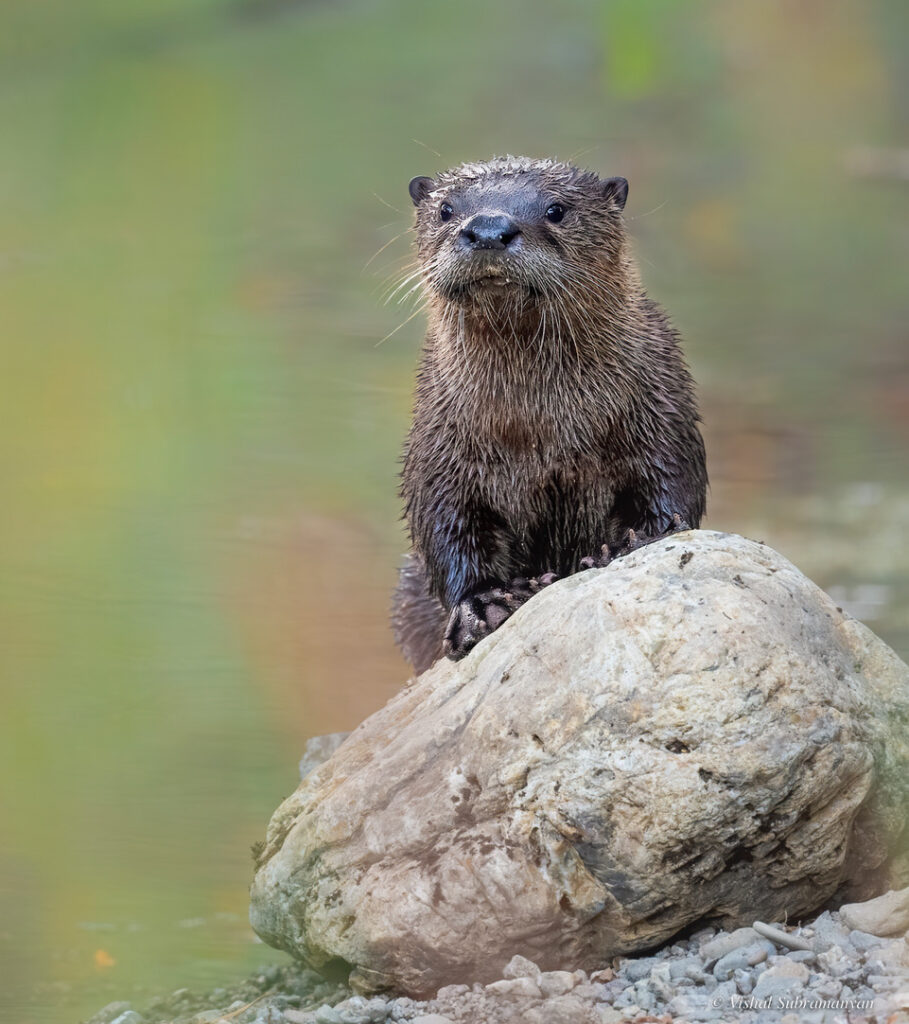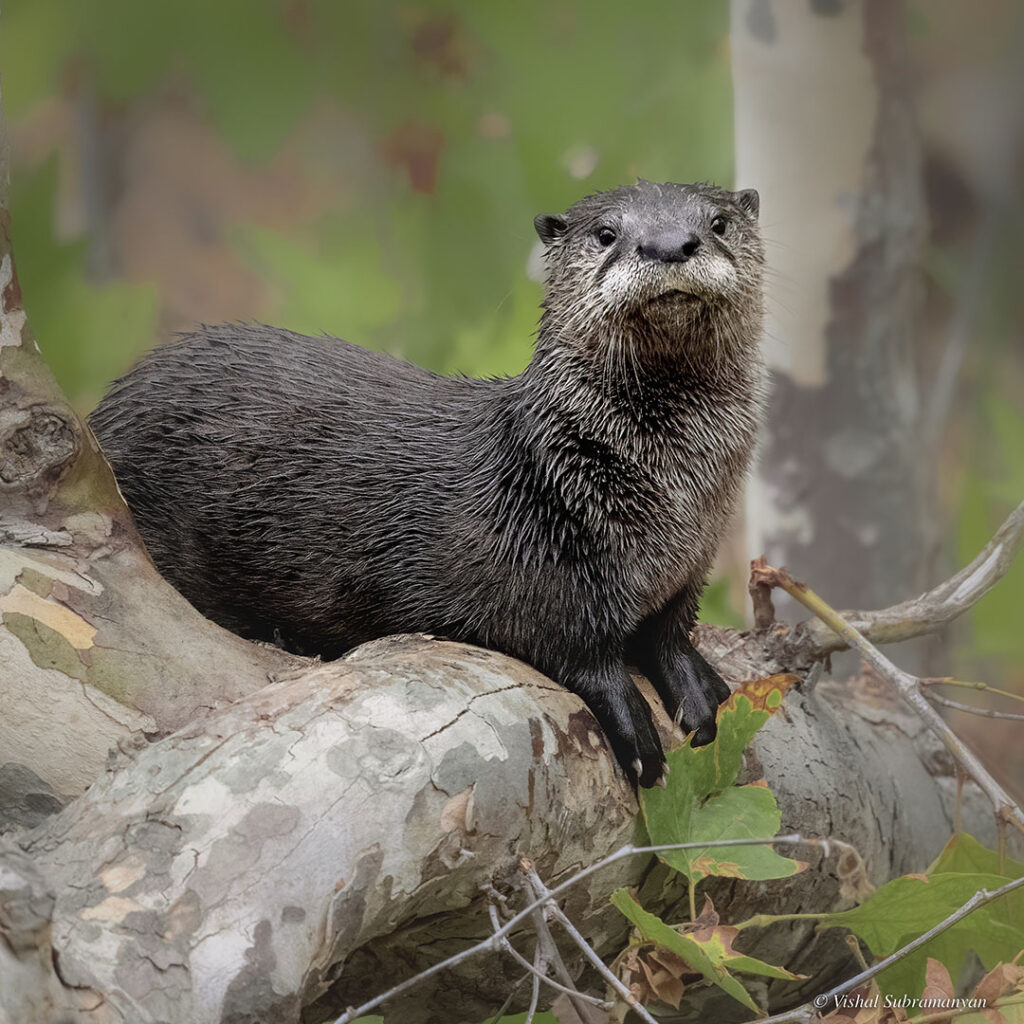by Joe Eaton

River Otters (Photos: Vishal Subramanyan)
(Full article from RATS Tales March 2023)
North American river otters would appear to be unlikely candidates for anticoagulant rodenticide (AR) exposure. These charismatic members of the weasel family eat fish and aquatic invertebrates (notably crayfish), supplemented by amphibians, aquatic mammals like beavers and muskrats, and water birds; some California otters have been known to tackle brown pelicans and mute swans. Rats and mice aren’t normally on the menu. However, a recent study found AR residues in 17 percent of the otters in a sample from Pennsylvania watersheds, adding to a growing body of evidence that ARs are entering and moving through aquatic food webs.
Fur trappers eliminated river otters from most of their North American range, including most of Pennsylvania; a remnant population persisted in the northeastern corner of the state, near the New York border. A reintroduction program began in the state’s northeastern and north-central regions in the 1990s, and trapping was allowed to resume shortly afterward. “The otters moved into several places where they hadn’t been before,” says biologist Aaron Facka, formerly with the Pennsylvania Game Commission.
Pennsylvania trappers are required to turn otter carcasses in to the state agency for analysis. “We were interested in how the population was doing, looking at age and sex ratios,” Facka explains. He and his colleagues decided to look for rodenticides as well, adding roadkills to a sample of otters trapped from 2019 to 2022. “People asked, ‘Why are we sampling otters?’” he recalls. “It was partly a logistical thing. We though we should just test. There had been more rodenticide work on terrestrial predators [like fishers] and scavengers. Otters and fishers have similar life histories. Would they have similar rates of exposure? If rodenticides were just in terrestrial systems, we wouldn’t see anything in otters. You don’t know until you look.”
When the livers of 105 otters were examined, trace amounts of the first-generation AR (FGAR) diphacinone and the second-generation AR (SGAR) brodifacoum were found in eighteen, with a larger amount in a nineteenth animal. Facka says exposure appeared to be widespread: “We found them across the state, in all regions and the majority of major watersheds—the Allegheny, the Delaware, the Susquehanna.” The highest proportion of exposures for otters and other carnivore species was around Philadelphia. The study didn’t deal with sublethal effects of AR poisoning or concurrent diseases; Facka says that there haven’t been a lot of otter disease studies. He cautions that scavenging of land vertebrates can’t be ruled out as an exposure pathway: “All the mustelids [weasel relatives] are pretty happy to scavenge.” But aquatic prey seems a more probable route.
Elsewhere in North America, and in Europe and Africa, ARs have been detected in otters and other water-associated mammalian carnivores. ARs were found in a couple of road-killed otters in the San Francisco Bay Area, and in the late 1990s, the FGAR chlorophacinone and the SGAR bromadiolone were found in a sample of Eurasian otters from southwestern France, as well as American mink (an invasive species in Europe) and in one specimen of the increasingly rare native European mink. French scientists suggested a possible source in campaigns to eradicate nutria, an invasive aquatic rodent originally from South America. Bromadiolone was later detected in otters in the Loire watershed.
In South Africa, Laurel Serieys, a key figure in demonstrating the connection between AR exposure and mange in California bobcats, tested roadkilled mammalian carnivores and raptors from the Cape Town area; 44 percent of nine Cape clawless otters, a species that feeds primarily on freshwater crabs, were positive for the SGARs brodifacoum, bromadiolone, and difenacoum. Serieys and her team noted that rodent control operations had not occurred in the riparian areas where the otters were found, concluding: “…we suspect that otters have been exposed via contaminated waterways….” Bromadiolone turned up in a water mongoose, another crab-eater that also takes frogs and fish.
There’s little data on fish-eating birds, but two studies on the closely related Eurasian white-tailed eagle and North American bald eagle are suggestive. The two eagles have varied diets, including fish and waterfowl in addition to land mammals and carrion. Brodifacoum and bromadiolone residues were present in 109 of 116 bald eagles from the eastern US, predominantly from Florida (60) and Georgia (35), collected from 2014 to 2018. In Germany, scientists detected difenacoum, brodifacoum, and bromadiolone in 38 percent of 60 white-tailed eagles in a 2004-2015 sample.
Only a handful of studies have addressed ARs in fish and other aquatic organisms. One publication reported three SGARs in bream from multiple German watersheds. Also in Germany, Julia Regnery and colleagues found SGARs in carp kept as pollution sentinels at wastewater treatment facilities, and in fish downstream from treatment plants. In the Queich River, gudgeons, bottom-feeding fish that are a major food source for European otters, had the highest AR concentrations. German researchers suggested that extreme rainfall events flushed AR baits from storm sewers into rivers. Other studies report ARs in fish and marine invertebrates after rat eradication campaigns on Ulva Island off the cost of New Zealand (blue cod, mussels, limpets) and Palmyra Atoll in the South Pacific (black-spot sergeant fish.)
These findings may be just the tip of a toxic iceberg. Understanding the extent of AR contamination in aquatic ecosystems will require systematic testing of freshwater and marine fish and aquatic invertebrates and the many bird and mammal species that depend on them for food. Fish in historically polluted San Francisco Bay are monitored for a range of chemicals of human health concern, but not for rodenticides. But as Aaron Facka put it, you don’t know what’s out there until you look.


